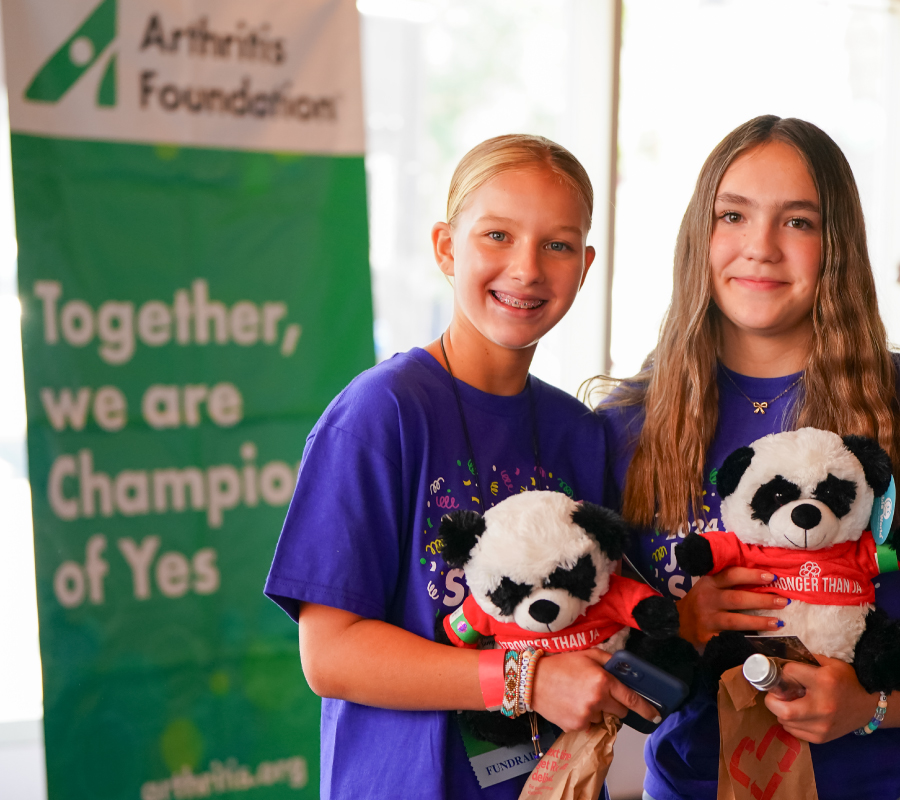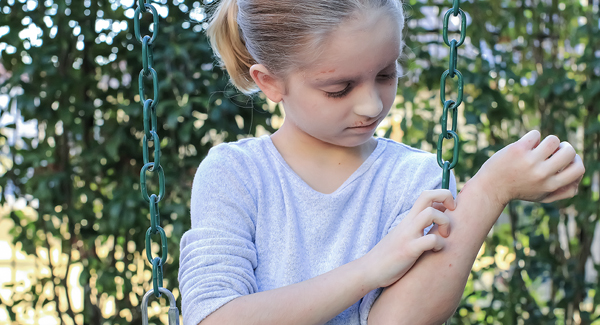Juvenile Arthritis (JA)
Juvenile arthritis affects hundreds of thousands of kids and teens in the United States.
Most kinds of JA are autoimmune or autoinflammatory diseases. That means the immune system, which is supposed to fight against foreign invaders like viruses and germs, instead releases inflammatory chemicals that attack healthy cells and tissue. In most JA cases this causes joint inflammation, swelling, pain and tenderness, but some types of JA have few or no joint symptoms or only affect the skin and internal organs.
The exact causes of JA are unknown, but researchers believe that certain genes may cause JA when activated by a virus, bacteria or other external factors. There is no evidence that foods, toxins, allergies or lack of vitamins cause the disease.
JA Explained
This series aims to provide parents and caregivers with expert tips and recommendations on topics around juvenile arthritis.
JA Health Effects
Here are some of the symptoms and health effects of JA:
Joints: May cause joints to look red or swollen and feel stiff, painful, tender and warm. This can cause difficultly moving or completing everyday tasks. Joint symptoms may worsen after waking up or staying in one position too long.
Skin: Skin symptoms may include a scaly red rash (psoriatic), light spotted pink rash (systemic), butterfly shaped rash across the bridge of the nose and cheeks (lupus) or thick, hardened patches of skin (scleroderma).
Eyes: Dryness, pain, redness, sensitivity to light and trouble seeing properly caused by uveitis (chronic eye inflammation).
Internal organs: Can affect internal organs such as the digestive tract (diarrhea and bloating), lungs (shortness of breath) and heart.
Other symptoms: Include fatigue (feeling extremely tired or rundown), appetite loss and high spiking fever.
Diagnosis
A pediatrician may start to determine what’s causing symptoms, but parents may be referred to a rheumatologist, a doctor with specialized training in treating arthritis. Some rheumatologists treat only children, while others treat only adults, and others treat both.
The doctor will ask questions about the child’s medical history, when symptoms started, how long they have lasted and about the child’s family history. He or she will also perform a physical exam to look for signs of JA, like limited range of motion, rash, eye symptoms and joint swelling, tenderness and pain.
Diagnostic tests include laboratory tests that look for inflammatory markers and imaging (X-rays, CT scans, MRIs) to look for signs of joint damage and help rule out other causes, like trauma or infection.
Types of JA
The most common types of JA include:
- Juvenile idiopathic arthritis. Juvenile idiopathic arthritis is the most common form of juvenile arthritis and includes six types: oligoarthritis, polyarthritis, systemic, enthesitis-related, juvenile psoriatic arthritis and undifferentiated.
- Juvenile myositis. An inflammatory disease that causes muscle weakness. There are two types: Juvenile polymyositis and juvenile dermatomyositis, which also causes rash on the eyelids and knuckles.
- Juvenile lupus. An autoimmune disease that can affect the joints, skin, internal organs (i.e. heart, kidneys, lungs) and other areas of the body. The most common form is systemic lupus erythematosus, or SLE.
- Juvenile scleroderma. Scleroderma, which literally means “hard skin,” describes a group of conditions that causes the skin to tighten and harden.
- Vasculitis. This type of disease causes inflammation of the blood-vessels, which can lead to heart complications. Kawasaki disease and Henoch-Schonlein purpura (HCP) are the most common kinds in kids and teens.
- Fibromyalgia. Fibromyalgia is a chronic pain syndrome that can cause widespread muscle pain and stiffness, along with fatigue, disrupted sleep and other symptoms. It is more common in girls but rarely diagnosed before puberty.
Treatments
There is no cure for JA, but with early diagnosis and aggressive treatment, remission (little or no disease activity or symptoms) is possible.
The goals of JA treatment are to:
- Slow down or stop inflammation and prevent disease progression.
- Relieve symptoms, control pain and improve quality of life.
- Prevent or avoid joint and organ damage.
- Preserve joint function and mobility for adulthood.
- Reduce long-term health effects.
A well-rounded plan includes medication, physical activity, acupuncture, massage, mind-body therapies) and healthy eating habits.
Medications
There are several kinds of medications used to treat JA. Some control disease activity and others relieve symptoms. Drugs that control disease activity include corticosteroids and disease-modifying antirheumatic drugs (DMARDs).
- Corticosteroids. These quick-acting, anti-inflammatory drugs are given by injection in a doctor’s office. They are typically used to manage disease until other medications start working because of side effects.
- Disease-modifying antirheumatic drugs (DMARDs). This class of drugs, which includes traditional DMARDS (methotrexate, sulfasalazine) and biologics, relieve symptoms by suppressing the immune system so it doesn’t attack the joints. Methotrexate is the most commonly used DMARD to treat JA. Traditional DMARDs may be available in pill form, but biologics are injected or given by infusion in a doctor’s office.
- Drugs that relieve symptoms. Nonsteroidal anti-inflammatory drugs (NSAIDs) and analgesics (pain relievers) relieve pain but cannot reduce joint damage or change the course of the disease. These medications are available over the counter or by prescription.
Every child with JA is different, and treatment depends on disease severity and type. The doctor may start with a modest approach, beginning with NSAIDs, analgesics and/or one type of DMARD (usually methotrexate), or choose a more aggressive approach that involves starting with a biologic or DMARD-biologic combo to combat inflammation as quickly as possible. These days, most doctors prefer early, aggressive treatment to slow disease progression rather watchful waiting. As doctors monitor the disease, drugs may be added or removed.
Surgery
Most children with JA will never need surgery, but joint replacement can help kids with severe pain or joint damage. Many procedures may be performed on an outpatient basis.
Non-drug therapies
Exercise. Regular exercise is key to managing joint stiffness and pain. Low-impact and joint-friendly activities like walking, swimming, biking and yoga are best, but kids with well-controlled disease can participate in just about any activity they wish, if their doctor or physical therapist approves. On tough days, it’s important to balance light activity with rest. Taking breaks throughout the day protects joints and preserves energy.
Physical Therapies and Assistive Devices
Physical therapy and occupational therapy can improve a child’s quality of life by teaching them ways to stay active and how to perform daily tasks with ease. Here are some other ways physical and occupational therapists can help a child with JA:
- Teach and guide them through strengthening and flexibility exercises.
- Help improve balance and coordination.
- Perform body manipulation.
- Prescribe and show kids how to use assistive devices (e.g. braces, splints, hand grips
Self-Care
It’s important that children and teens make healthy lifestyle choices and use complementary therapies to manage the pain and stress of arthritis. These include:- Healthy eating. Eating some foods, like those found in the Mediterranean diet (i.e. fatty fish, fruits, vegetables, whole grains and extra virgin olive oil), and avoiding others (high-fat, sugary and processed foods) may help curb inflammation.
- Hot and cold therapies. Heat treatments, such as heat pads or warm baths, work best for soothing stiff joints and tired muscles. Cold is best for acute pain. It can numb painful areas and reduce inflammation.
- Topicals. Creams, gels or stick-on patches can ease the pain in a joint or muscle. Some contain the same medicine that’s in a pill, and others use ingredients that irritate nerves to distract from pain.
- Mind-Body Therapies. Meditation, deep breathing, distraction techniques (listening to music or reading) and practicing visualization can help relax and divert attention away from pain, especially during shot time.
- Massage and Acupunture. Massage may help reduce pain and ease stress or anxiety. Acupuncture involves inserting fine needles into the body along special points to relieve pain. If there’s a fear of needles, acupressure, which uses firm pressure, may be used instead.
- Supplements. The use of supplements is rarely studied in children, but some supplements that help adults may help children, too. Ask a doctor about which supplements and vitamins may be helpful and which ones may cause side effects and medication interactions.
- Stress and Emotions. Kids and teens with chronic diseases are more likely to get depressed. Therapists and psychologists can help kids deal with tough emotions and teach positive coping strategies. A strong support system of friends and family can also provide emotional support during tough times.
Children can meet friends at various Arthritis Foundation JA events held throughout the year, and teens can participate in the Foundation’s iPeer2Peer program, which matches them with a young adult mentor who also has arthritis.
Hear firsthand accounts of how juvenile arthritis affects lives. Warning: inspiration ahead!

Connect with Us
Get the latest news and updates on our Juvenile Arthritis resources and events. Sign up by providing your information in the form.
















